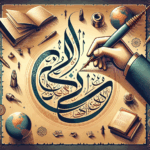Comparing Arabic Alphabet Learning Methods: Books vs. Apps 📚📱
Learning the Arabic alphabet is an exciting journey that opens doors to a rich language and culture. But with so many resources available, how do you choose the best method for you? In this post, we’ll explore the pros and cons of learning the Arabic alphabet through traditional books and modern apps. By the end, you’ll have a clearer idea of which method suits your learning style. Let’s dive in!
Table of Contents
1. Introduction
2. The Traditional Route: Books 📚
3. The Modern Approach: Apps 📱
4. Factors to Consider 🤔
5. Conclusion
6. FAQs
The Traditional Route: Books 📚
Books have been a timeless resource for learning new languages, and the Arabic alphabet is no exception. Here are a few reasons why books might be your go-to choice:
1. Tangible Learning Experience: There’s something special about holding a book in your hands. Flipping through pages, jotting down notes in the margins, and using bookmarks can make the learning process feel more personal and interactive.
2. Structured Learning: Most language books are designed with a clear progression in mind, which can help beginners gradually build their skills. This structured approach often includes exercises, practice sheets, and quizzes to reinforce learning.
3. No Screen Time: For those looking to reduce their digital exposure, books offer a screen-free alternative. It’s a great way to give your eyes a rest while still being productive.
The Modern Approach: Apps 📱
In our digital age, language learning apps have emerged as a popular tool for learners. Here’s why you might consider them for mastering the Arabic alphabet:
1. Interactive Features: Apps often include interactive games, quizzes, and instant feedback, making the learning process engaging and fun. These interactive elements can help reinforce what you’ve learned and keep you motivated.
2. Accessibility and Convenience: With apps, you can learn anytime and anywhere. Whether you’re on your daily commute or waiting in line, apps make it easy to squeeze in a quick study session.
3. Multimedia Elements: Many apps offer audio pronunciations, visual aids, and even video lessons. These multimedia resources cater to different learning styles and can be particularly helpful for auditory and visual learners.
Factors to Consider 🤔
When choosing between books and apps, consider the following factors:
1. Your Learning Style: Do you prefer a structured, traditional approach, or do you thrive on interactivity and spontaneity?
2. Budget: While some apps are free or low-cost, books can sometimes be a one-time purchase. Consider what fits your budget and offers the best value for your learning needs.
3. Goals: Are you learning for personal enjoyment, travel, or professional purposes? Your goals might influence which method is more suitable for you.
Conclusion
Both books and apps offer unique advantages for learning the Arabic alphabet. Your choice ultimately depends on your personal preferences, learning style, and goals. Whether you choose the tactile experience of a book or the convenience of an app, the most important thing is to stay consistent and enjoy the process. Happy learning!
FAQs
Q1: Can I use both books and apps to learn the Arabic alphabet?
A1: Absolutely! Combining both methods can provide a well-rounded learning experience, allowing you to benefit from the strengths of each.
Q2: Are there any free resources for learning the Arabic alphabet?
A2: Yes, many apps offer free versions with basic features, and there are also free online resources and libraries where you can access Arabic learning books.
Q3: How long does it take to learn the Arabic alphabet?
A3: The time it takes can vary based on your dedication and learning pace. With regular practice, some learners become familiar with the alphabet in a few weeks.
Q4: What are some popular apps for learning the Arabic alphabet?
A4: Popular apps include Duolingo, Memrise, and Rosetta Stone, each offering unique features to aid your learning journey.
Q5: Do I need to learn the Arabic alphabet if I just want to speak the language?
A5: While it’s possible to learn spoken Arabic without knowing the script, understanding the alphabet can significantly enhance your reading and writing skills and deepen your overall comprehension.






